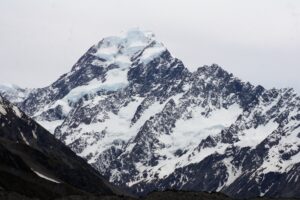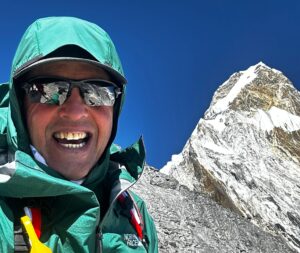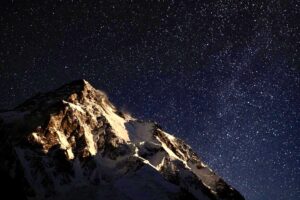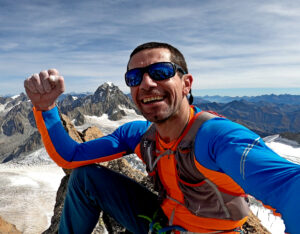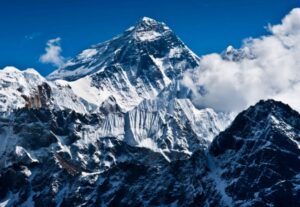Everest, by north or by south? More than ever, that dilemma vexes climbers who dream of setting foot on the top of the world. In the coming years, though, the question might change to, which side can you afford?
In the last two decades, the Tibetan option has often seemed less appealing, promising a nightmare of red tape, restricted movement within the country, unpredictable edicts from Chinese authorities –- not to mention the fierce winds sweeping the Tibetan plateau. Why would anyone climb Everest from the north?
Until recently, there were two reasons: First, a more lax attitude toward age and disability. Nepal has banned kids under 16 from climbing Everest, and in 2017, it refused permits for both the visually impaired and double amputees. The second reason was money: Climbing fees on the North side cost less. But neither reason is true anymore.

Everest’s North side Base Camp, at the head of the Rongbuk Valley, Tibet. Photo: Furtenbach Adventures
Last year, China imposed a new set of regulations clearly aimed to better control foreign climbers and to increase the profits from summit-hunters. Although the number of permits was lower than in previous years, higher penalty deposits were required to ensure that no trash remained and that the climbers (or their insurance companies) bore all rescue costs.
Restrictions on Nepali outfitters were also announced, although later softened. The climbing fee per person on Everest’s North side increased to $9,950 plus a $1,500 trash deposit — virtually the same as Nepal’s $11,000 per person. (all US dollars)
For extra suspense, right before the climbing season began, China closed the mountain to foreigners while they conducted a clean-up operation. Companies were finally allowed in (and enjoyed the freshly paved road to Base Camp and non-polluting vehicles), but the uncertainty discouraged some teams that had not yet made up their minds.
The result: Everest’s South side became more crowded than ever, with nearly 400 permits — a record — issued just to foreign climbers, including significant numbers of newbies. Some cut-rate outfitting companies offered cheaper-than-ever rates. A short summit window did the rest. The impressive summit figures were shadowed by the worldwide scandal over the chaos on summit day, with hundreds of climbers waiting in line. Some froze to death, others ran out of oxygen. Eleven died, some allegedly due to delays and crowding.

The gaggle near the top of Everest, South side. Photo: Furtenbach Adventures
The bad publicity prompted Nepal to create an advisory panel. In August, it came up with a set of recommendations, requiring future Everest climbers to prove previous experience on a 6,500m peak or higher within Nepal and to show that they had spent at least $35,000 on their expedition.
The panel also directed outfitters to provide personnel with previous 8,000m experience and hinted at environmentally-friendly requirements to come. A corresponding increase in climbing fees was rumored, although no confirmation as yet. Nepal’s parliament will apparently debate the recommendations sometime before spring 2020, probably not in time to enforce them this year.
Last week, it was China’s turn to move on the Everest chessboard. Its China Tibet Mountaineering Association announced steeply increased fees, especially for individual climbers and Nepali nationals, from BC staff to Sherpa guides. Foreign teams must stay at assigned hotels and are driven to Base Camp in government-managed vehicles, in either “standard” or “luxury” style.
For “standard” climbers, the overall fee (climbing permit plus garbage deposit, which totalled $11,450 in 2019) increases to $15,800 in 2020. Four-person groups may choose an $18,000 “luxury” option, which includes five-star hotels in Lhasa and four-star accommodation along the drive to BC in 4×4 vehicles. In this last case, the fee has actually lessened a bit compared to 2019. Tibet’s other two 8,000’ers, Cho Oyu and Shishapangma, have seen similar increases.
Fees for Nepali staff also increase significantly, which affects both Nepali outfitters and companies hiring Nepali porters and guides. Nepal nationals on Everest will be charged $4,500, compared to last year’s $3,300, while their fees on Cho Oyu and Shishapangma will total $4,000.
With Nepal’s Everest fees still at $11,000, Tibet has become for the first time more expensive. But the cost might be worth it, and not just to avoid the crowds, according to Everest guide and outfitter Lukas Furtenbach.
“This minor price increase comes with increased safety and comfort,” he told ExplorersWeb. “Electricity and 4G network in Base Camp, a real working garbage and waste-water management system and a Sherpa rescue team based at ABC during the summit push.” For the last several years, he added, the North side has been significantly safer and more successful than the South.

Enjoying loneliness at Camp 2 on Everest’s North side. Photo: Lukas Furtenbach/Furtenbach Adventures
Indeed, according to the Himalayan Database, the summit/death ratio on Everest between 2008 and 2018 is as follows: On the South side, we have 3,865 summits and 65 deaths (1.6%). The North side had 1,652 summits and 13 deaths (0.7%).
As for success rates, the South side had 6,847 attempts and 3,865 summits (56% success) while on the North, out of 2,723 attempts, 1,652 reached the top (60% success).
While the stats slightly favor the North, Nepal’s indirect advantages include more acclimatization peaks and treks, an easygoing country with friendly locals, freedom to move about without Big Brother and the tourist draw of colourful Kathmandu. Some may even prefer to acclimatize in Nepal, then head for the Tibet side of Everest.
Lukas Furtenbach, whose company is guiding both sides of Everest for the first time next spring, admits that some of his clients are unsure which to choose. “In the next few years, I can see the North becoming the premium side,” he suggests, “with only certified, strictly monitored companies and higher quality (more experienced) clients.”

Austrian guide Lukas Furtenbach avoided the crowds by climbing from the North side in spring 2019 and will launch expeditions from both sides in 2020. Photo: Furtenbach Adventures
In the short term, we might find that those able to pay more head for Tibet, while climbers on a tight budget come to Nepal, hoping for long summit windows but prepared to endure the crowds.
What about the other Tibetan 8,000’ers?
China’s swelling fees definitely come as bad news for those eyeing Shishapangma or Cho Oyu. Because these peaks offer relatively straightforward normal routes (at least until Shisha’s central summit and Cho Oyu’s summit plateau), they have traditionally been popular as first 8,000’er experiences. They used to host expeditions in both spring and fall, which also drew collectors hoping to notch several 8,000m peaks in one year, or those seeking to avoid the post-monsoon crowds on Manaslu.

The beautiful yet highly challenging south face of Cho Oyu, as seen from Gokyo. Photo: Uwe Dedering
The increased cost on these two lesser Chinese peaks makes Nirmal Purja’s recent offer to open a new commercial route on Cho Oyu from the Nepal side more appealing. Purja is looking for clients to tackle the 8,210m summit without entering China. A first glimpse of the proposed route suggests its one downside as a commercial alternative: There seems to be no easy line up that ragged, steep face.
Related stories:
Everest North Side Closed for Spring Cleaning

